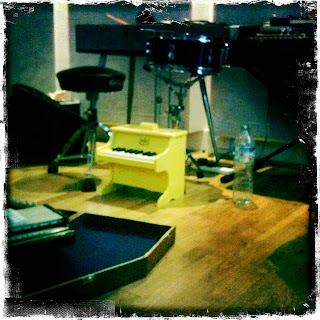I was very lucky to be introduced, by a producer friend of mine, to the very talented duo Brains & Hunch -Tom Haines & Chris Branch.
I met Chris briefly, at a Christmas party, and a month or so later dropped B&H an e-mail about the project. Luckily they liked the script and so were interested in working on the film. I went to meet Tom at their studio in Hoxton in early March, and we got on really well. He was very keen on the story and the references that I mentioned from Desplat to Morricone. Tom has a background as a percussionist, and we discussed perhaps making cardboard instruments and incorporating lots of live sound into the score. It was a great first meeting, and I went away feeling really positive, with a few cds to listen to and ideas to think on. What impressed me about the guys was the very unique, modern feel of their work and also the fact that they continually get involved in a variety of different projects from theatre, to animation, to live music (with their band The London Snorkelling Team). This gives their work a variety and energy that I really like.
So over the next few months I liaised with Tom, sporadically going into the studio for sessions, and bringing all manner of biscuits and cakes with me for sustenance. So serious were we about our biscuits at these sessions, that one day we even discussed the merits of the fig roll, it's status as Über food stuff, and superior/inferior brands, for what must have been a good half an hour...Tom can explain it to you...It has to do with cycling.
I also like that their studio is an Aladdin's cave of cool instruments:
 |
| Chris (left) on guitar, and Tom (right) in the driving seat |
Throughout the whole process we exchanged notes and versions of the score and thus, I feel, we were able to tailor it to really compliment the film. Their enthusiasm, and their willingness not only to listen to my musings and requests, but endeavour to interpret them musically and add them into the score, was both impressive and very much appreciated.
Guilty
From very early on, once I had decided on the Bear eating Pig ending, I wanted to use the track Guilty to finish on. The Al Bowlly version of this beautiful track is featured in the film Amélie. Again I really liked the idea of juxtaposing such a sophisticated, elegant song with the images of cute, slightly psychotic woodland creatures. And so began the battle to secure usage of the track from EMI with little to no budget. Here, all my thanks must go to Charlie Stanfield at Independent who fought til the bitter end to make this happen for me. So in mid June I went back into the studio, and we re-recorded our own version, performed by Chris Branch and sung by Pascal Wyse. Although we only used a few lines, I really enjoyed directing all the nuances in Pasc's voice. I am very happy with our version, and I think it really helps to give the ending more impact and that darkly comic feel that I wanted.
 |
| The London Snorkelling Team with Pascal far right |










